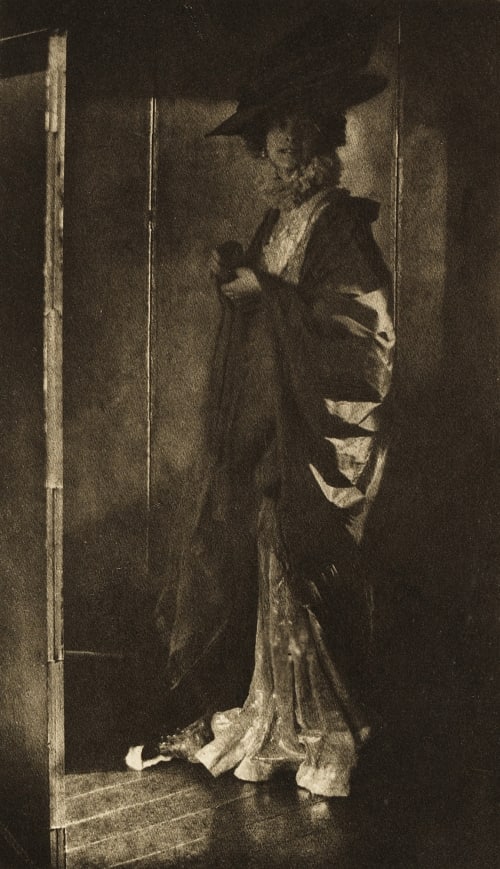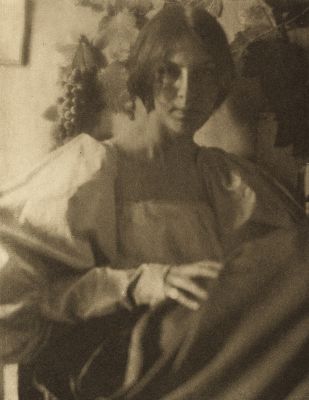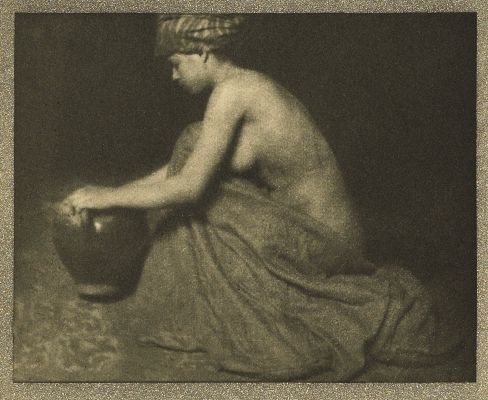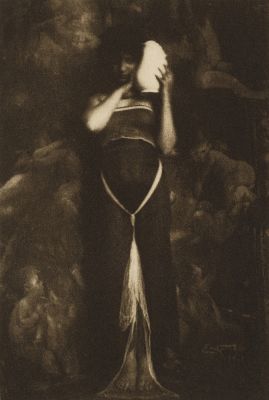
Title
The Silver SkirtArtist
De Meyer, Baron Adolf (American, 1868-1946)Publication
The Artistic Side of PhotographyDate
1910Process
PhotogravureAtelier
Alvin Langdon CoburnImage Size
15 x 8.5 cm
This well-received book advocating pictorial photography was published simultaneously in New York, London and Toronto. Anderson, an English author, thoroughly covered creative photography and its technical side in the text. The 12 rich, small hand-pulled photogravures were all by leading pictorialists of the time; Alvin Langdon Coburn, F. Holland Day, Baron Adolf De Meyer, Frank Eugene, Gertrude Käesebier, George H. Seeley, Edward Steichen, Alfred Stieglitz and Clarence H. White. Coburn who, characteristically etched his own plates, consulted with the publisher and oversaw the quality of all the photogravures. Demonstrating the international nature of the movement, the photographers hail from England, France, Italy, and the United States. Equally impressive is the fact that the book was published nearly simultaneously in three countries: England (Stanley Paul and Company, London, 1910), Canada (Copp, Clark Company, Toronto, 1910), and America (Dodd Mead and Company, New York, 1911). The leading monthly American Photography reviewed the book, exclaiming that “Mr. Anderson has produced in this comprehensive and clearly written exposition of pictorial photography by far the most illuminating and helpful treatise on the subject which has appeared in some years.” (July 1911, page 437). The book, in fact, was so successful that another edition was issued a few years later (1913 in New York and London, 1916 in Toronto). Retitled The ABC of Artistic Photography, perhaps to appeal to a less sophisticated audience, it was slightly smaller in scale and page count, although it covered all the same topics. Not surprisingly, the number of photogravures was also reduced, to just four. (Peterson)
Baron Adolf de Meyer spent his childhood in Paris and Germany. He exhibited photographs as an amateur photographer when he was around twenty-six years old. The following year he relocated from Dresden to London, where he was admitted to the Royal Photographic Society and the Linked Ring. He maintained a professional correspondence and friendship with Alfred Stieglitz; de Meyer’s photographs were published in several issues of Stieglitz’s publication Camera Work and he eventually joined Stieglitz’s Photo-Secession. In 1913 de Meyer’s first photograph was published in Vogue magazine and in 1914 publisher Condé Nast hired de Meyer as Vogue magazine’s first full-time photographer, also contracting him to work for Vanity Fair. In 1921 he left Nast to work for the William Randolph Hearst publication Harper’s Bazaar in Paris, where he became the preeminent fashion photographer of the day. From early on and especially during his magazine years, de Meyer associated with and photographed the upper echelons of society. Around 1934, a new editor with a mission to redefine the renamed Harper’s Bazaar led to the end of de Meyer’s illustrious career with the magazine. After travels in Europe, he relocated to Hollywood at the end of the thirties. He died in Los Angeles, remembered for his famous friends but virtually forgotten as a photographer.
The Getty has a 1910 platinum print:
The Silver Skirt
[Portrait of Mrs. Gingold, London, England] (Alternate Title)
[Portrait of a Woman] (Alternate Title) — The Getty










